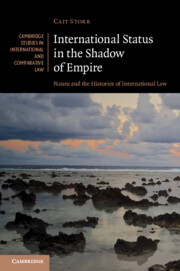Book contents
- International Status in the Shadow of Empire
- Cambridge Studies in International and Comparative Law: 150
- International Status in the Shadow of Empire
- Copyright page
- Contents
- Illustrations
- Acknowledgements
- Prologue
- 1 International Status, Imperial Form: Nauru and the Histories of International Law
- 2 From Trading Post to Protectorate, 1888
- 3 From Protectorate to Colony to Mandate, 1920
- 4 From Mandate to Trust Territory, 1947
- 5 From Trust Territory to Sovereign State, 1968
- 6 After Independence: Sovereign Status and the Republic of Nauru
- Bibliography
- Index
- Cambridge Studies in International and Comparative Law
2 - From Trading Post to Protectorate, 1888
Published online by Cambridge University Press: 20 August 2020
- International Status in the Shadow of Empire
- Cambridge Studies in International and Comparative Law: 150
- International Status in the Shadow of Empire
- Copyright page
- Contents
- Illustrations
- Acknowledgements
- Prologue
- 1 International Status, Imperial Form: Nauru and the Histories of International Law
- 2 From Trading Post to Protectorate, 1888
- 3 From Protectorate to Colony to Mandate, 1920
- 4 From Mandate to Trust Territory, 1947
- 5 From Trust Territory to Sovereign State, 1968
- 6 After Independence: Sovereign Status and the Republic of Nauru
- Bibliography
- Index
- Cambridge Studies in International and Comparative Law
Summary
Chapter 2 traces Nauru’s incorporation into the arena of European imperial competition, first as a trading outpost of a Hanseatic firm from Hamburg, then as part of the German protectorate of the Marshall Islands. It traces the activity of Hanseatic firms in the Pacific and Africa in the late nineteenth century, and examines the significance of Hanseatic activity to the geography of German protectorates declared around the Berlin Conference in 1884, and the relationship between that activity and the Australasian federation movement. The chapter moves to assess the relationship between the protectorate concept and the actual forms of protectorate that proliferated from the mid-1880s, when the label was applied to diverse imperial forms involving vague and often contradictory assertions of sovereignty, property and territory. It argues that the protectorate concept bore little relation to the actual balance of company and state rule struck between the Reich and the Jaluit Gesellschaft in 1888 in Nauru. It concludes that this distinction between status and form establishes a new perspective from which to retrace the shift from imperial to international administration in the twentieth century.
Keywords
- Type
- Chapter
- Information
- International Status in the Shadow of EmpireNauru and the Histories of International Law, pp. 45 - 99Publisher: Cambridge University PressPrint publication year: 2020



